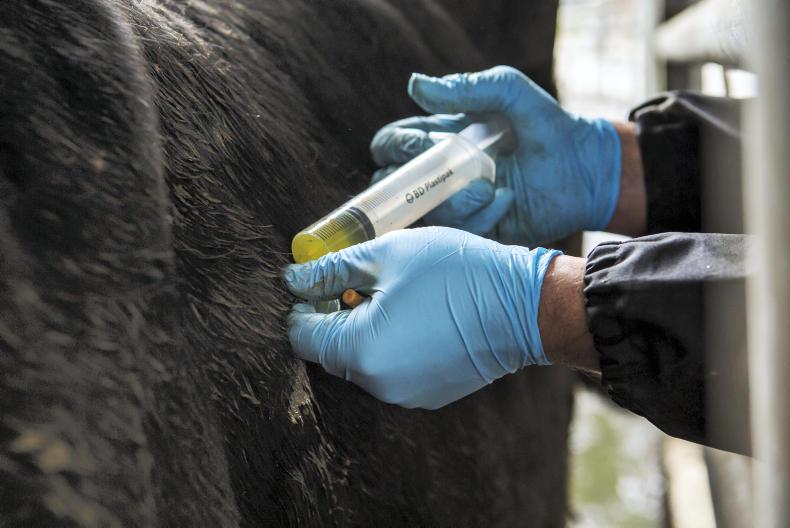Nutritional additives such as probiotics, essential oils, plant extracts, and supplements that rely on the principle of quorum sensing, can all have positive effects on cattle health, but none are a “silver bullet” solution, a Nuffield Farming Scholarship report has concluded.
Completed by local vet Dr Mark Little, technical manager for Trouw Nutrition Ireland, his study looked at the role of feeding management in combating antimicrobial resistance in cattle, with visits conducted to farms in the US as well as across Europe.
His work found that many of these feed additives are not as effective at keeping cattle healthy as antibiotics and also tend to be more expensive, while needing further investment in research and development to improve their activity. In addition, they are not a substitute for good management.
However, Little concluded if these products are used on farms where herd management is already good, and fed at the right time, they can lead to herd health benefits.
The premise of Little’s study is that antibiotic resistance is a serious threat to human and animal health. Across the UK and the EU, farmers are under significant pressure to reduce drug use, with ever tightening rules on who can prescribe antibiotics and how they should be administered. However, Little’s report raises serious questions about antibiotic use in other parts of the world.
“In many countries, antibiotics are supplied without regulation, prescription or even professional advice on usage,” his report notes.
The use of antibiotic growth promoters in animals was banned by the EU in 2006. In 2017, the US also implemented a ban, however, during a visit to a Texas farm finishing 1.2m cattle per year, Little found that antibiotics were still used in large quantities as growth promoters in feedlot production.
Big three
Two of the “big three” feed additives in widespread use in the US are Monensin (Rumensin), which is used to increase weight gain and improve feed efficiency and Tylosin (Tylan), used to reduce the incidence and severity of liver abscesses.
The main cause of liver abscesses is a high starch/low fibre diet typical of an American feedlot. In one on-farm study, where some cattle were put on a high fibre diet meaning Tylosin was not required, the cattle grew slower and took longer to reach slaughter weight, resulting in a loss in income of $28/head.
The third feed additive in widespread use are beta agonists, which increase feed efficiency, but are banned in the EU since 1996.
Most cattle producers in the US also implant their cattle with growth-promoting hormones.
According to Little’s report, during his visit to the US, he challenged the operators of a feedlot on why they continue to use two different in-feed antibiotics continuously in finishing cattle.
“It was responded with the strong view that other countries, such as Thailand and China, use more antibiotics in food producing animals, therefore this practice was not considered bad” he noted.
Little also visited a Texan agricultural store where he found antibiotics, including some defined as Critically Important by the World Health Organisation, freely available to purchase without a prescription. The report includes a photograph where a range of drugs, including some with expired use by dates, were in a “50% off” sale.
Read more
Temporary suspensions handed to vets who broke antibiotic protocol
Pressure to reduce antibiotics in beef and sheep
Nutritional additives such as probiotics, essential oils, plant extracts, and supplements that rely on the principle of quorum sensing, can all have positive effects on cattle health, but none are a “silver bullet” solution, a Nuffield Farming Scholarship report has concluded.
Completed by local vet Dr Mark Little, technical manager for Trouw Nutrition Ireland, his study looked at the role of feeding management in combating antimicrobial resistance in cattle, with visits conducted to farms in the US as well as across Europe.
His work found that many of these feed additives are not as effective at keeping cattle healthy as antibiotics and also tend to be more expensive, while needing further investment in research and development to improve their activity. In addition, they are not a substitute for good management.
However, Little concluded if these products are used on farms where herd management is already good, and fed at the right time, they can lead to herd health benefits.
The premise of Little’s study is that antibiotic resistance is a serious threat to human and animal health. Across the UK and the EU, farmers are under significant pressure to reduce drug use, with ever tightening rules on who can prescribe antibiotics and how they should be administered. However, Little’s report raises serious questions about antibiotic use in other parts of the world.
“In many countries, antibiotics are supplied without regulation, prescription or even professional advice on usage,” his report notes.
The use of antibiotic growth promoters in animals was banned by the EU in 2006. In 2017, the US also implemented a ban, however, during a visit to a Texas farm finishing 1.2m cattle per year, Little found that antibiotics were still used in large quantities as growth promoters in feedlot production.
Big three
Two of the “big three” feed additives in widespread use in the US are Monensin (Rumensin), which is used to increase weight gain and improve feed efficiency and Tylosin (Tylan), used to reduce the incidence and severity of liver abscesses.
The main cause of liver abscesses is a high starch/low fibre diet typical of an American feedlot. In one on-farm study, where some cattle were put on a high fibre diet meaning Tylosin was not required, the cattle grew slower and took longer to reach slaughter weight, resulting in a loss in income of $28/head.
The third feed additive in widespread use are beta agonists, which increase feed efficiency, but are banned in the EU since 1996.
Most cattle producers in the US also implant their cattle with growth-promoting hormones.
According to Little’s report, during his visit to the US, he challenged the operators of a feedlot on why they continue to use two different in-feed antibiotics continuously in finishing cattle.
“It was responded with the strong view that other countries, such as Thailand and China, use more antibiotics in food producing animals, therefore this practice was not considered bad” he noted.
Little also visited a Texan agricultural store where he found antibiotics, including some defined as Critically Important by the World Health Organisation, freely available to purchase without a prescription. The report includes a photograph where a range of drugs, including some with expired use by dates, were in a “50% off” sale.
Read more
Temporary suspensions handed to vets who broke antibiotic protocol
Pressure to reduce antibiotics in beef and sheep









SHARING OPTIONS